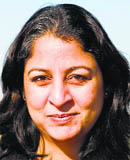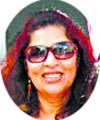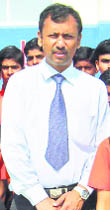|
Lessons of life
At the dawn of a new year, a look at some idealists who believe in building a brave new world. They are driven by the desire to provide education to underprivileged children and have brought about innovations in teaching
Kavita Kanan Chandra
 Just
enrolment in schools does
not mean access to quality education
for children. In our country's rural hinterland and urban slums there
are many government and private schools that teach children. But only
a few schools provide quality education. When a fourth grade student
could not write a complete sentence in a rural government school,
girls in urban slums work as housemaids rather than get educated or a
village lacking electricity lets education go for a toss; there is
need to worry. Sending these kids to school is not a solution in
itself but ensuring proper education is. Just
enrolment in schools does
not mean access to quality education
for children. In our country's rural hinterland and urban slums there
are many government and private schools that teach children. But only
a few schools provide quality education. When a fourth grade student
could not write a complete sentence in a rural government school,
girls in urban slums work as housemaids rather than get educated or a
village lacking electricity lets education go for a toss; there is
need to worry. Sending these kids to school is not a solution in
itself but ensuring proper education is.
Educationists like
Safeena Husain (Mumbai), Urvashi Sahni (Lucknow) and Chandrakant Singh
(Bangalore) were aghast to witness the above situations and became
beacons of hope for these children. Some innovations in the school
model, method of teaching and use of technology by these educationists
went a long way in reforming the education system, thus giving the
underprivileged children a chance to get quality education. It is a
must for every child in order to be able to compete on a level playing
field. "How could children with no access to quality education
ever compete with those who have that privilege?"
In the process, these
educationists are also trying to give special attention to girls'
enrolment and their retention in classrooms so that the gender gap in
education gets reduced considerably.
Safeena
Husain (Mumbai)
 Safeena,
an alumnus of the London School of Economics, is dedicated to
reforming the education system in Rajasthan's rural government
schools. Through her NGO "Educate Girls," she is
spearheading education of girls. Starting from 2007, over 52,000 girls
have been enrolled in 5,700 schools in Pali, Jalore and Sirohi. They
also campaign to send child brides to school and eradicate the system
since Rajasthan has a large percentage of child brides. An innovation
like "community ownership" concept helps to engage the
parents of the students' to assess the infrastructure of government
schools and to hold them accountable for lapses. Most parents are
illiterate, so she has made an action plan where she has listed the
visual tools that are mandatory in a government school like toilets,
classrooms, mid-day meals etc. It was found that only 40 per cent
schools had girls' toilet and this was one reason why girl students
had poor attendance. Safeena ensured there was a democratically
elected parent's council and over 4,000 school management committees
were formed. Parents were taught about their rights while doing school
assessment and demand for improvement. Safeena,
an alumnus of the London School of Economics, is dedicated to
reforming the education system in Rajasthan's rural government
schools. Through her NGO "Educate Girls," she is
spearheading education of girls. Starting from 2007, over 52,000 girls
have been enrolled in 5,700 schools in Pali, Jalore and Sirohi. They
also campaign to send child brides to school and eradicate the system
since Rajasthan has a large percentage of child brides. An innovation
like "community ownership" concept helps to engage the
parents of the students' to assess the infrastructure of government
schools and to hold them accountable for lapses. Most parents are
illiterate, so she has made an action plan where she has listed the
visual tools that are mandatory in a government school like toilets,
classrooms, mid-day meals etc. It was found that only 40 per cent
schools had girls' toilet and this was one reason why girl students
had poor attendance. Safeena ensured there was a democratically
elected parent's council and over 4,000 school management committees
were formed. Parents were taught about their rights while doing school
assessment and demand for improvement.
Through "team
Balika," she motivates educated girls in age group of 18-22 to
provide informal education in a fun-filled way to government school
students. There are 1,500 dedicated teacher volunteers. Among
students, over 30,000 girls have become school leaders by joining
bal sabhas. A survey of schools in 2005, showed Safeena how
children from government schools lacked basic education. Funds were
not an issue but the apathy of school administration, teachers and
bureaucracy was. Her NGO is in partnership with the Rajasthan
Government and a MOU of public-private partnership has been signe and
a district-level task force has been formed with a blanket permission
to work with the government. Three more districts and 10,000 schools
will be covered next year.
Dr.
Urvashi Sahni (Lucknow)
 An
educationist and social entrepreneur, Urvashi Sahni has a PhD from the
Graduate School of Education in University of California at Berkeley.
She has introduced the innovative concept of "Digital Study
Hall" (DSH) project, a technology-assisted cost-effective
distance learning project for underprivileged students. This provides
students from urban slums and rural areas access to quality teaching.
A user-friendly, video-sharing system, it helps to overcome the lack
of quality education due to a shortfall of good teachers in poor and
remote areas. This project entails recording of actual classroom
teaching of good schools with best teachers. The tapes are then played
in a government school where a teacher is trained to impart quality
education to the students. Many of these are single-teacher schools,
where the teachers lack the skill and training to impart quality
education to students. DVDs, web and media projectors are used and
regular intervals are given for interactive sessions based on video
content, so that an effective teaching-learning process is created. An
educationist and social entrepreneur, Urvashi Sahni has a PhD from the
Graduate School of Education in University of California at Berkeley.
She has introduced the innovative concept of "Digital Study
Hall" (DSH) project, a technology-assisted cost-effective
distance learning project for underprivileged students. This provides
students from urban slums and rural areas access to quality teaching.
A user-friendly, video-sharing system, it helps to overcome the lack
of quality education due to a shortfall of good teachers in poor and
remote areas. This project entails recording of actual classroom
teaching of good schools with best teachers. The tapes are then played
in a government school where a teacher is trained to impart quality
education to the students. Many of these are single-teacher schools,
where the teachers lack the skill and training to impart quality
education to students. DVDs, web and media projectors are used and
regular intervals are given for interactive sessions based on video
content, so that an effective teaching-learning process is created.
All eight KGBVs (Kasturba
Gandhi Balika Vidyalayas) in Lucknow are part of the DSH network. DSH
is all set to expand in 12 districts in the coming months, increasing
its outreach to 1,200 girls in KGBVs. They have recently added another
200 videos, in addition to the existing 2,000 in their digital
library. Over 6,000 students are using DSH videos. DSH has started
five informal education centres — one in Village Digdiga and four at
brick manufacturing sites for the children of the labourers, reaching
out to around 200 students. To create social awareness and gender
equality, DSH works beyond academics and its team has created videos
on domestic violence, sexual abuse, child marriage and other problems
being faced by girls in India.
Urvashi’s emphasis is
more towards educating the girl child. She founded the Studyhall
School in Lucknow, Vidyasthali Kanaar Primary School in Kanaar village
in Malhihabad district (UP) and a girls school "Prerna" in
Lucknow for those belonging to the low-income group.
Chandrakant
Singh (Bangalore)
 An
engineer with M.Tech degree from IIT Mumbai, five years back, when he
founded 'Chaitanya Gurukul Trust Public School' at nondescript village
Chamanpura in Gopalganj district of Bihar, Chandrakant ran the school
on generators for there was no electricity. Even then internet, Skype
and video conferencing were used to supplement classroom teaching
through lectures by eminent teachers in India's metro and even those
in the USA. The physical presence of a teacher could not be denied in
a classroom. Where expert guidance is required there is the use of
technology to bridge the gap. Providing quality education even in the
remotest and poor part of the country is an innovation that
Chandrakant experimented successfully. With electricity supply this
year, things have eased out a bit. The endeavour is to provide
world-class technology assisted education in a place where a very
rustic primary school existed and hardly any child got quality
education. There is Wi-Fi connectivity in the campus and most modern
educational and sports amenities are present. This includes a computer
lab and even a swimming pool. Guest lectures by eminent educationist
are encouraged and a lot of emphasis on recruitment of good teachers
is given. Teachers are selected through competitive exams and trained
in Bangalore. With many children getting good ranks in Olympiad tests;
the school has made a mark academically. The CBSE-affliated school's
first batch will appear for the Class X Board exams in 2015. In the
Olympiad first year 2011, 12 students; second year 2012 , 24 students
got ranks at the national level and one student from a poor family,
got 62 international rank. There are 600 students, including 60 girls.
Thirty per cent are poor students who pay no fees. An
engineer with M.Tech degree from IIT Mumbai, five years back, when he
founded 'Chaitanya Gurukul Trust Public School' at nondescript village
Chamanpura in Gopalganj district of Bihar, Chandrakant ran the school
on generators for there was no electricity. Even then internet, Skype
and video conferencing were used to supplement classroom teaching
through lectures by eminent teachers in India's metro and even those
in the USA. The physical presence of a teacher could not be denied in
a classroom. Where expert guidance is required there is the use of
technology to bridge the gap. Providing quality education even in the
remotest and poor part of the country is an innovation that
Chandrakant experimented successfully. With electricity supply this
year, things have eased out a bit. The endeavour is to provide
world-class technology assisted education in a place where a very
rustic primary school existed and hardly any child got quality
education. There is Wi-Fi connectivity in the campus and most modern
educational and sports amenities are present. This includes a computer
lab and even a swimming pool. Guest lectures by eminent educationist
are encouraged and a lot of emphasis on recruitment of good teachers
is given. Teachers are selected through competitive exams and trained
in Bangalore. With many children getting good ranks in Olympiad tests;
the school has made a mark academically. The CBSE-affliated school's
first batch will appear for the Class X Board exams in 2015. In the
Olympiad first year 2011, 12 students; second year 2012 , 24 students
got ranks at the national level and one student from a poor family,
got 62 international rank. There are 600 students, including 60 girls.
Thirty per cent are poor students who pay no fees.
More than innovation in
education, it is the self-sustaining revenue-generating model of the
school founded in a village that excites Chandrakant. He says that
even big corporates fear opening a school in a village but he has made
a success out of it even though 30 per cent of all students are
provided absolutely free education. The model is like a pyramid where
the total number of students is divided into three rungs, with the
ratio of 3:4:3. Starting from bottom rung that pay no fees, to the
middle rung that pays discounted fees, we come finally to the topmost
rung that pays the full fees. The payment of fees depends on the
capacity of the parents.
|